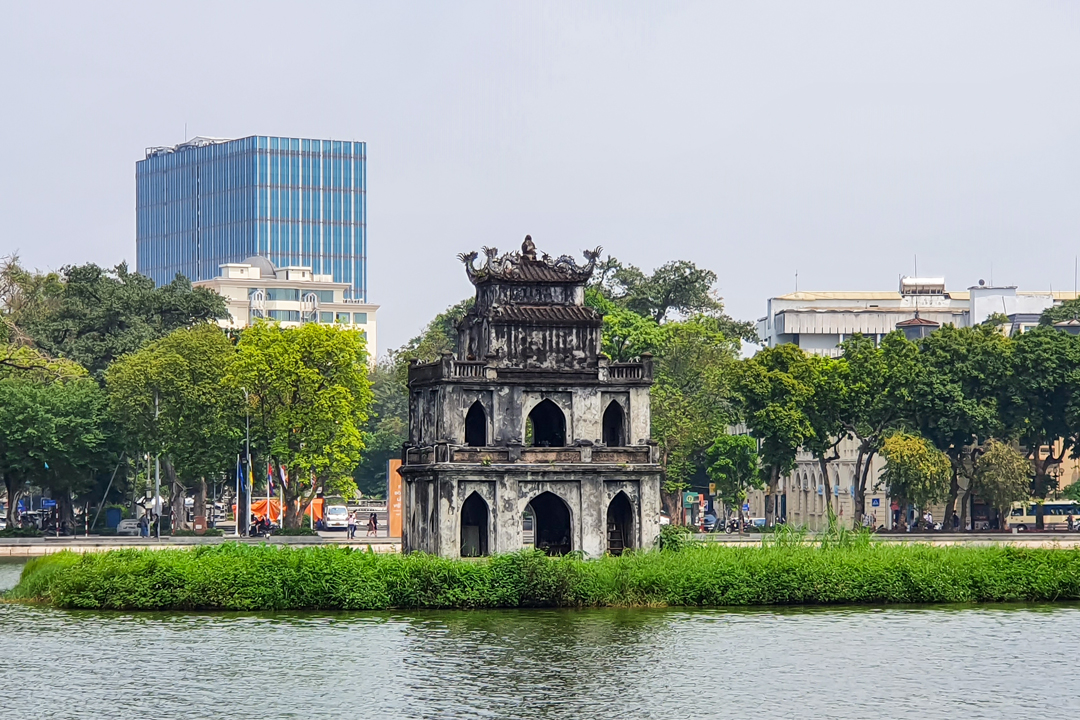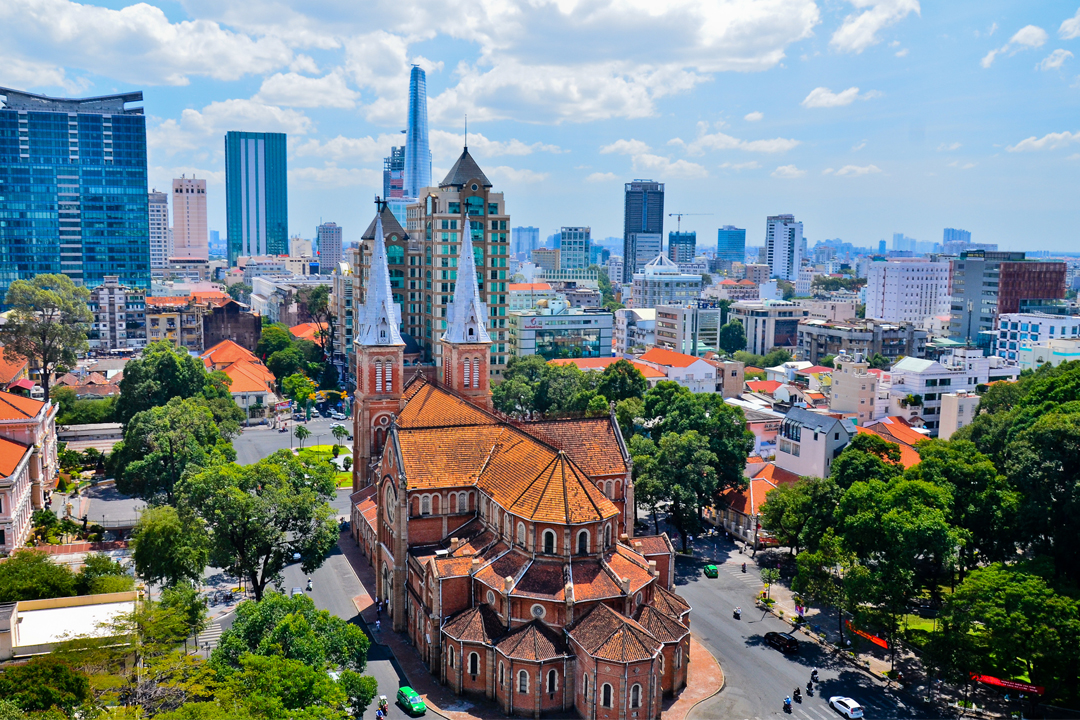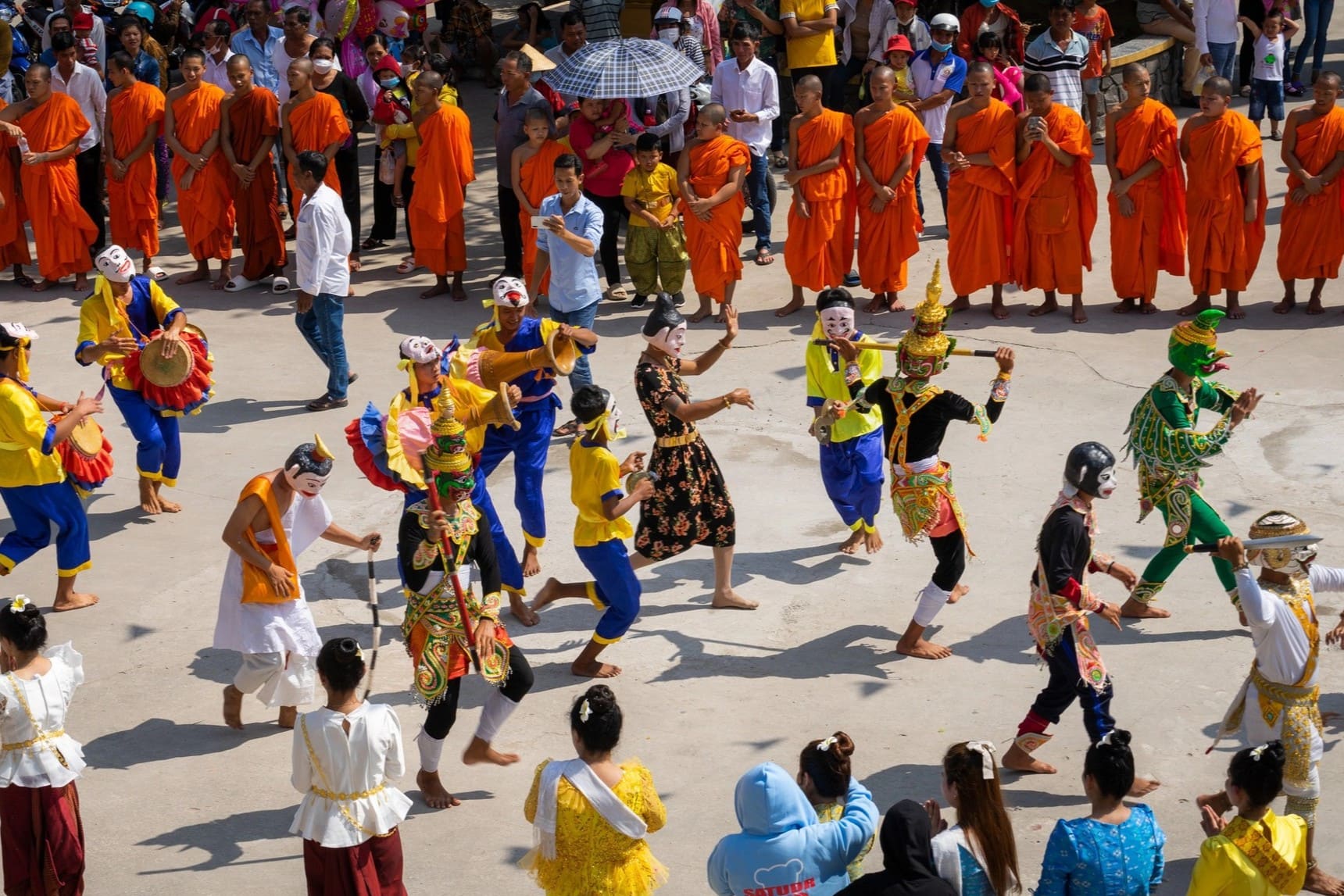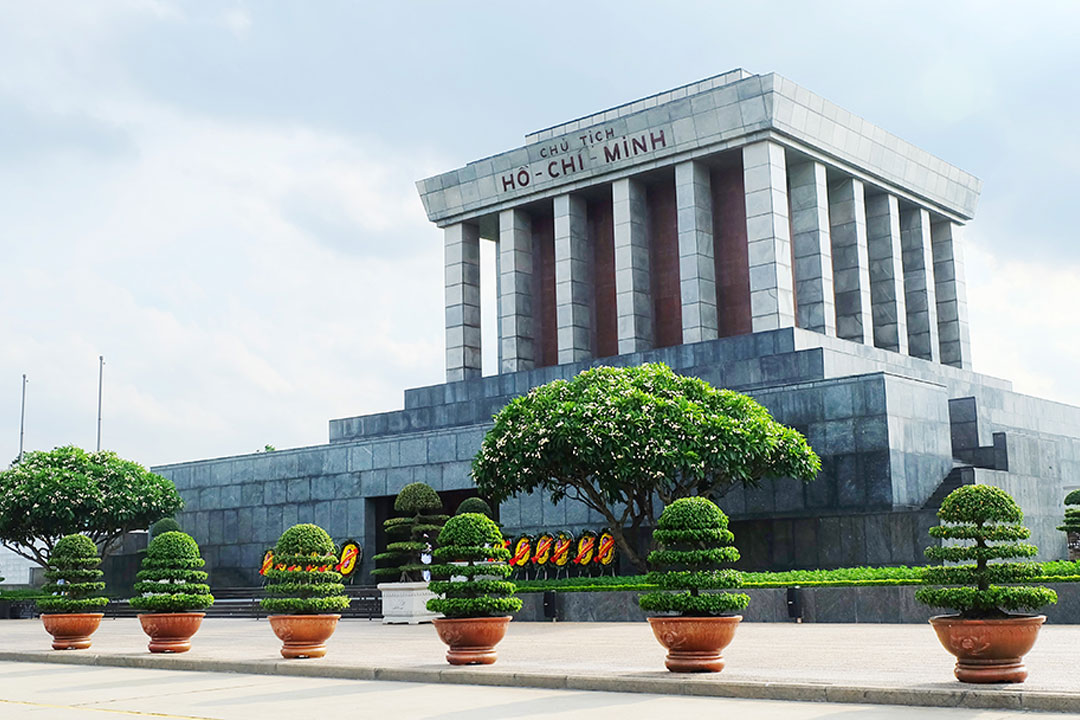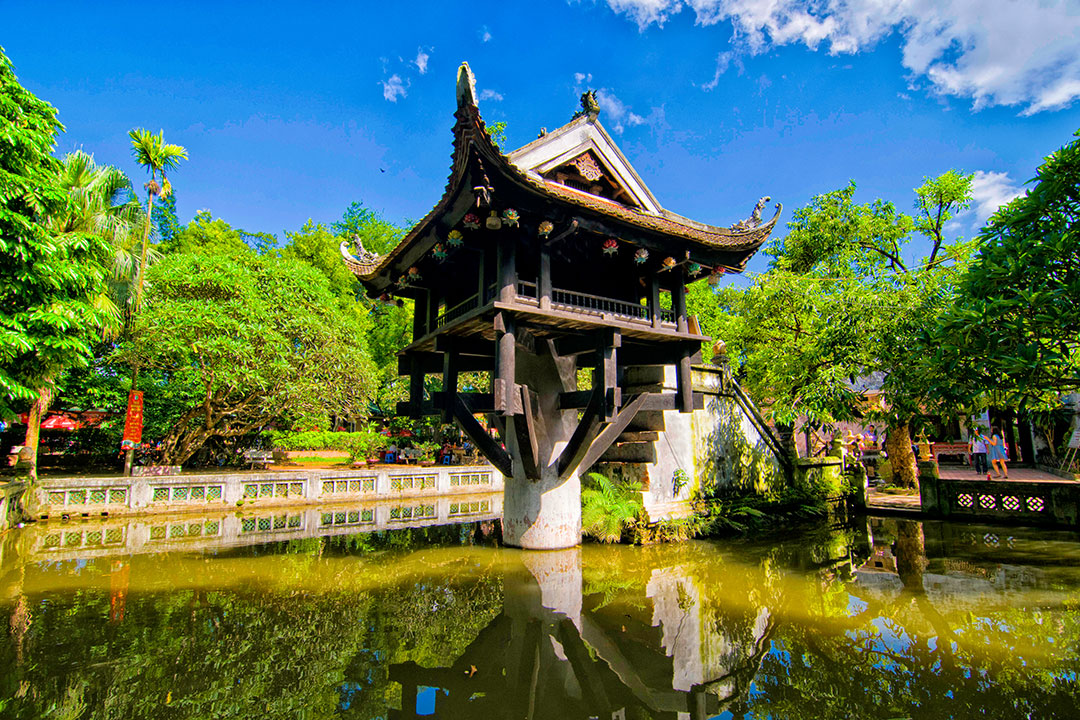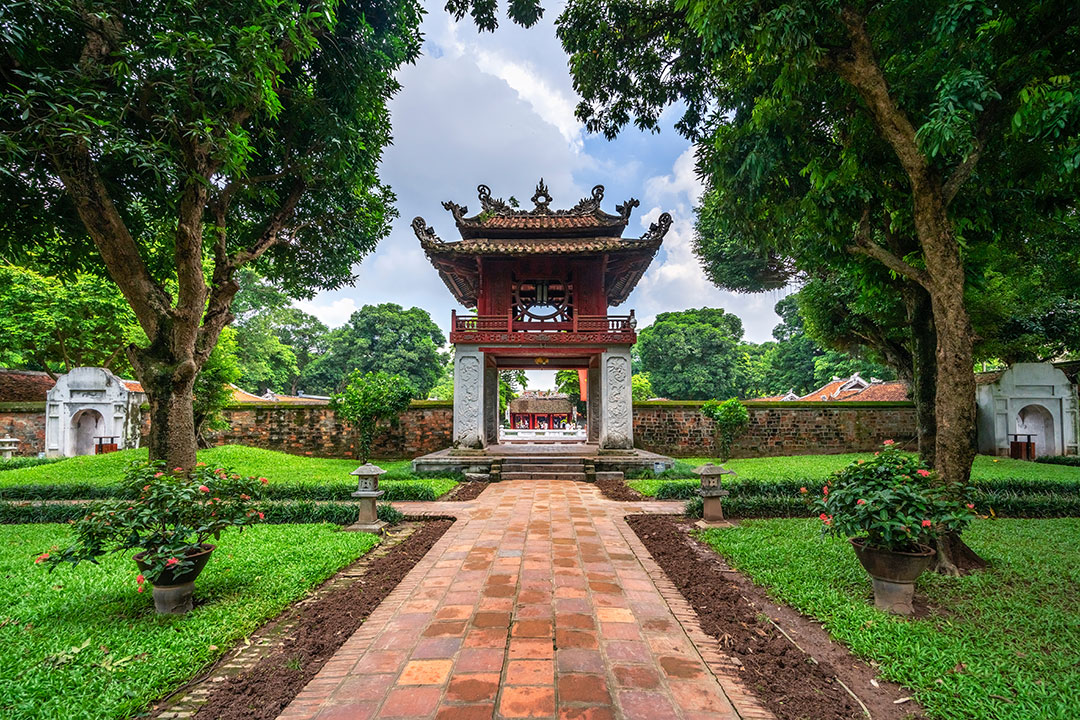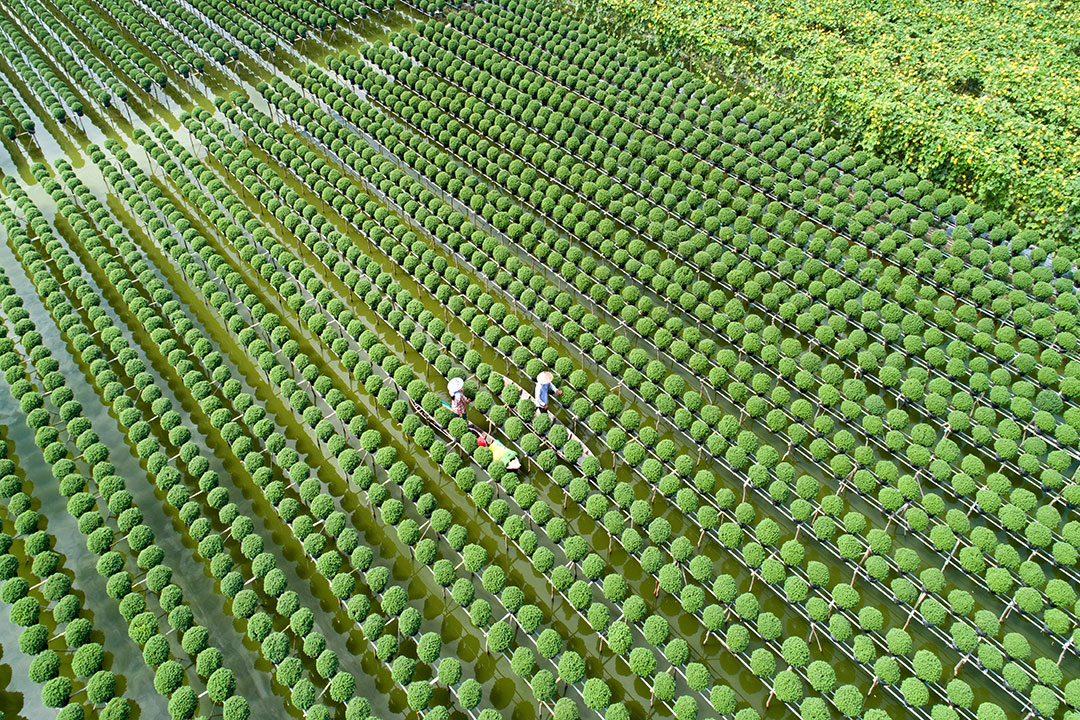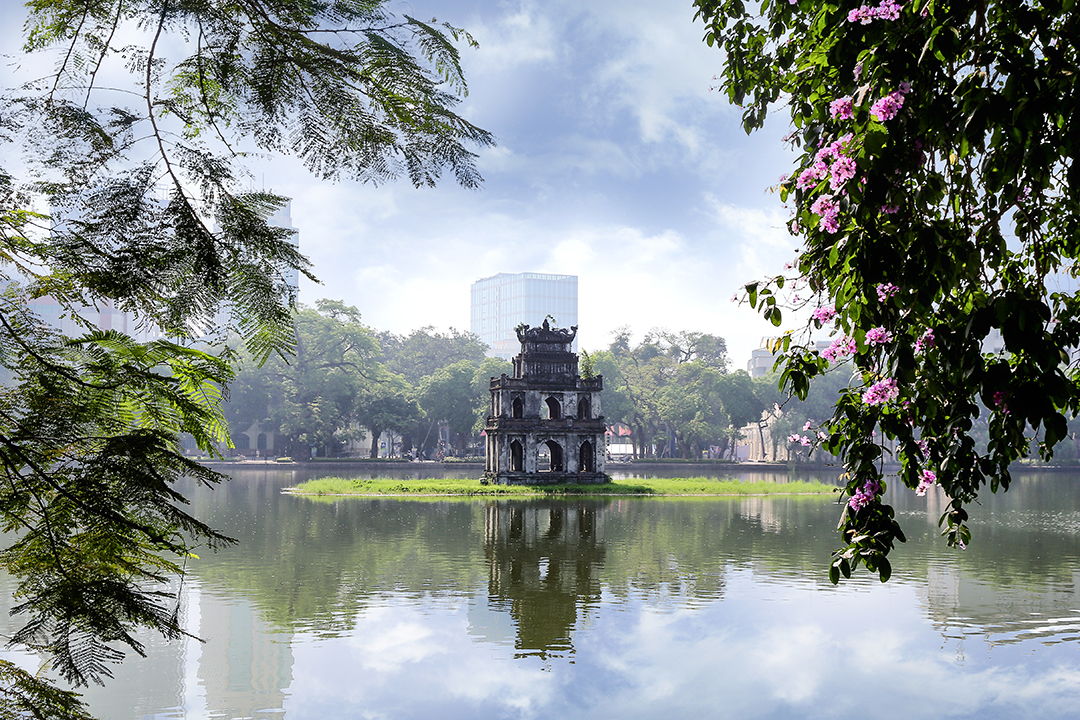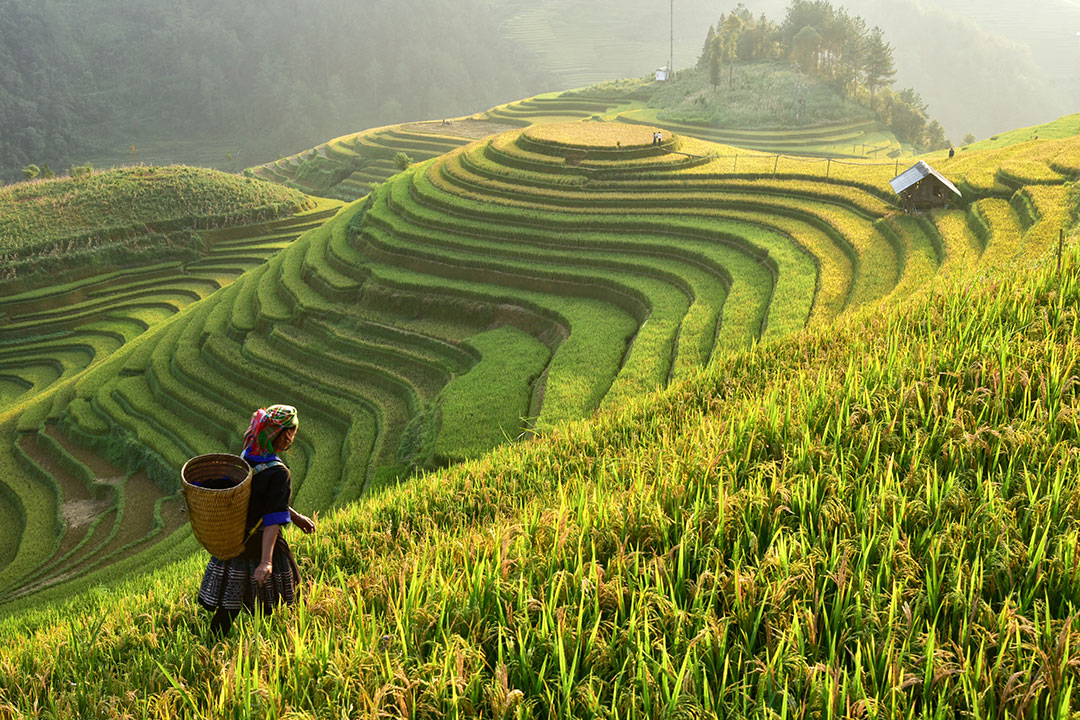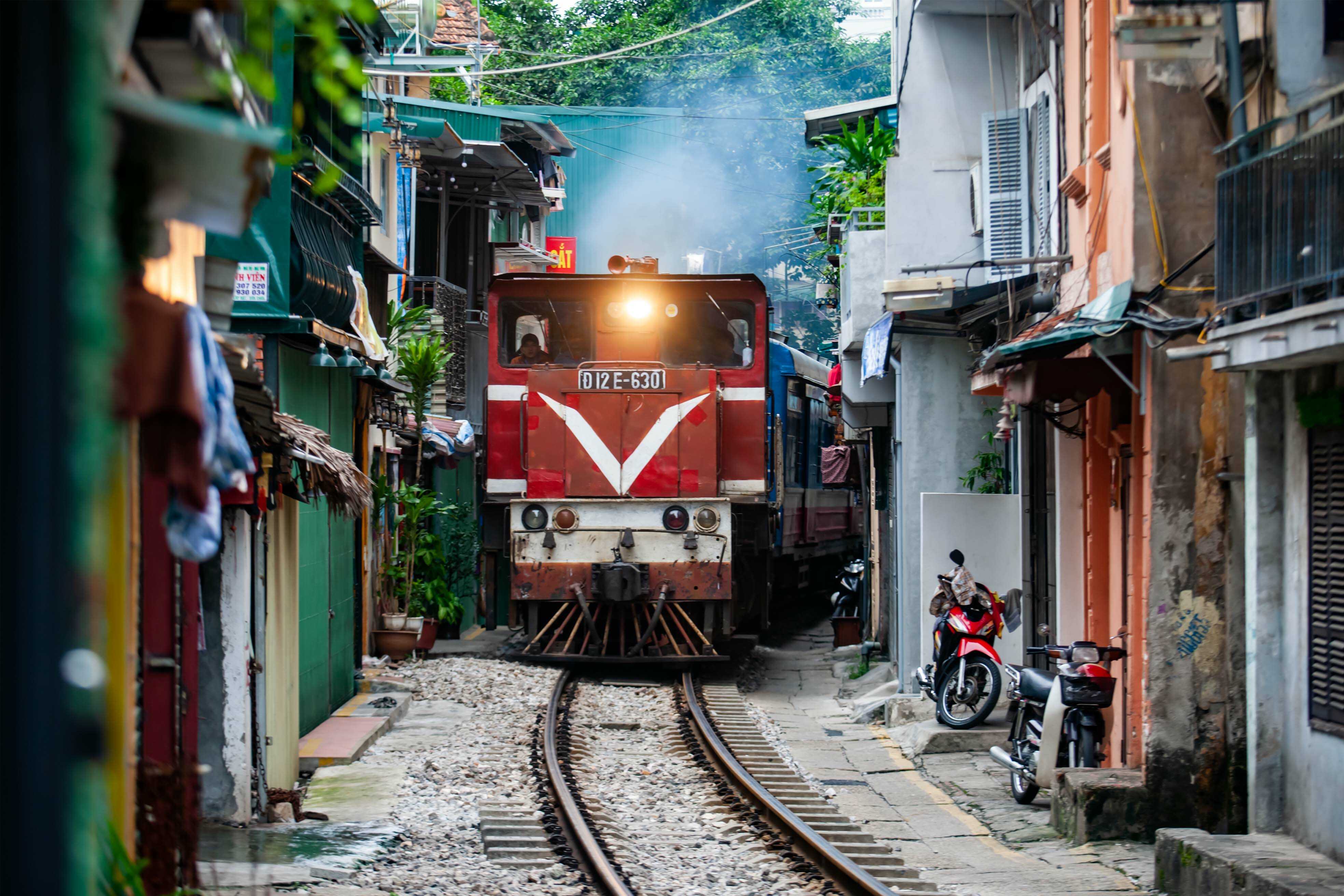Ba Dinh Square: History, Structure, Events, Things To Do & Travel Guide
In the heart of Hanoi lies Ba Dinh Square, a spacious and symbolic landmark where Vietnam’s modern history quietly unfolds. This is where President Ho Chi Minh declared the country’s independence in 1945, and where key national moments continue to take place. Surrounded by iconic structures like the Ho Chi Minh Mausoleum, the Presidential Palace, and the National Assembly Building, the square stands as a solemn yet open space.
What sets Ba Dinh Square apart is the way it weaves history, architecture, and civic life into one grand setting. The neatly arranged green lawns, wide walkways, and surrounding monuments create a peaceful atmosphere. The daily flag ceremonies and nearby cultural sites offer a deeper glimpse into Vietnam’s identity. In this article, GTrip explores Ba Dinh Square in detail, which offers a thoughtful pause in the middle of the capital.
History of Ba Dinh Square
Location: Hung Vuong Street, Ba Dinh Ward (Hung Vuong Street, Dien Bien Ward, Ba Dinh District, Hanoi)
Ba Dinh Square carries centuries of history that reflect the nation's transformation from imperial rule to independence. This 320,000-square-meter space has evolved from royal grounds to the symbolic heart of Vietnamese independence and national identity.
Originally part of the Thang Long Imperial Citadel, the area that would become Ba Dinh Square once served as royal grounds during the Nguyen Dynasty, hosting important court ceremonies. Under French colonial rule in 1894, it was transformed into a European-style garden called Le Parc Puginier, reflecting the colonial agenda of reshaping Vietnamese space and identity.
In 1945, the square was renamed after the Ba Dinh Uprising, symbolizing a return to national pride and resistance. That same year, it became a historic landmark when Ho Chi Minh declared Vietnam's independence here, marking its transformation from a colonial garden to a powerful symbol of the nation’s sovereignty.
Today, Ba Dinh Square functions as the ceremonial heart of Vietnamese political life:
- National ceremonies: The square hosts Vietnam's most significant government events, including National Day celebrations on September 2nd
Military paraRegular displays of Vietnam's defense forces occur here during major anniversaries
- Flag raising ceremonies: Daily ritual honoring Vietnam's national symbol
- State funerals: Final tributes to the nation's highest-ranking officials
- Diplomatic receptions: Welcoming of foreign dignitaries during state visits
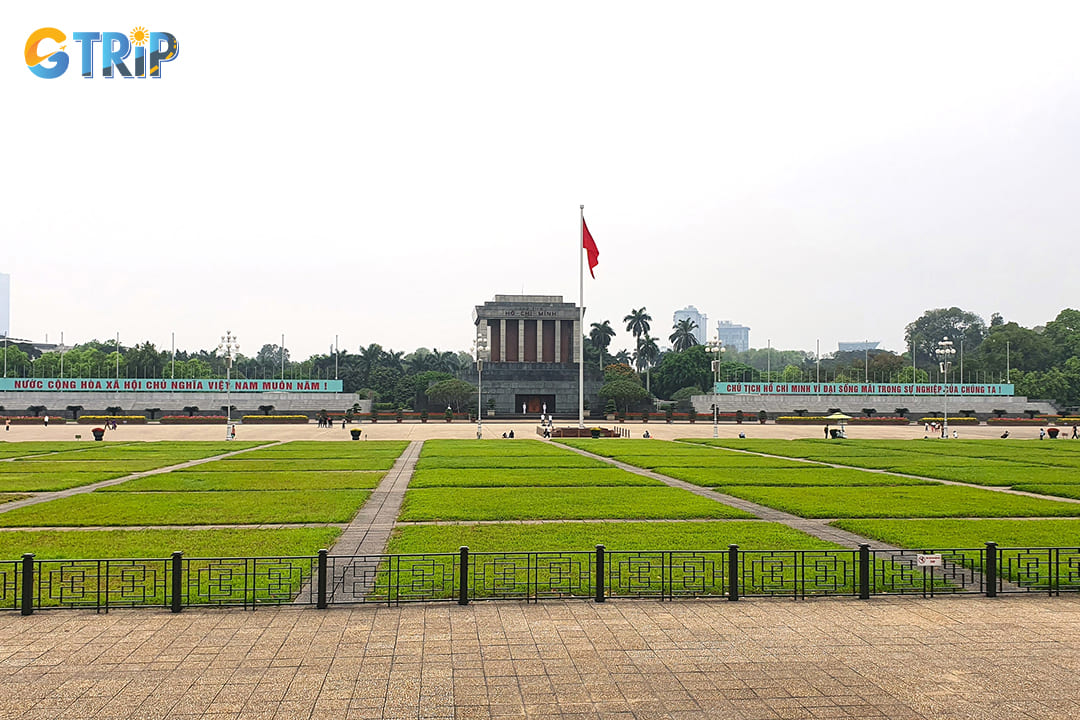
Ba Dinh Square carries centuries of history that reflect the nation's transformation from imperial rule to independence
The structure of Ba Dinh Square
Ba Dinh Square is Vietnam’s foremost political landmark, located in the center of Hanoi. Spanning 320 meters in length and 100 meters in width, it was designed to host major national events and accommodate up to 200,000 people. The square features 210 grass plots laid out in a symmetrical pattern, divided by concrete pathways that create a dignified and structured open space. Its design reflects both grandeur and order, reinforcing its role as the heart of the nation’s civic life.
At the northern end of the square stands the Ho Chi Minh Mausoleum, a solemn granite monument that houses the embalmed body of Vietnam’s revolutionary leader. Built in 1975, the mausoleum blends traditional Vietnamese architecture with Soviet-inspired elements, using gray stone to evoke strength and reverence. At the center of the square rises the national flagpole, where daily flag-raising and lowering ceremonies take place with military precision, symbolic rituals that draw both locals and travelers.
Surrounding Ba Dinh Square are several key government buildings that reinforce its importance. The Presidential Palace, a yellow colonial-era structure, adds historical depth to the area. The National Assembly Building, a modern complex serving as the seat of Vietnam’s parliament, and the Ministry of Foreign Affairs complete the square’s powerful architectural ensemble. Together, these structures create a space that is not only functional but symbolic, a living representation of Vietnam’s past, present, and future.

At the northern end of the square stands the Ho Chi Minh Mausoleum
Important national events take place at Ba Dinh Square
Ba Dinh Square is Vietnam’s most iconic political and historical landmark, located in the center of Hanoi. Measuring 240 meters in length and 160 meters in width, the square has served as the setting for some of the most defining moments in the country’s modern history. With its symmetrical layout, expansive lawns, and surrounding government buildings, Ba Dinh Square continues to be the ceremonial heart of the nation.
The square’s most significant moment came on September 2, 1945, when President Ho Chi Minh read the Declaration of Independence. This event officially established the Democratic Republic of Vietnam. Standing before a crowd of half a million people, his words marked the beginning of a new era. This event transformed Ba Dinh Square from a colonial-era garden into sacred ground, symbolizing the birth of an independent Vietnam.
Ba Dinh Square has played a pivotal role in showcasing Vietnam's national pride through a series of significant military parades. Here’s a quick overview of these historic events:
- January 1, 1955: The first military parade was held to celebrate the victory at Dien Bien Phu and introduce the People's Army to both the public and international observers.
- May 1, 1973: A parade marked the successful conclusion of the anti-American struggle following the signing of the Paris Peace Accords, symbolizing the end of foreign occupation.
- September 2, 1975: A grand parade commemorated the success of the August Revolution, 30 years of national establishment, and the reunification of Vietnam, showcasing a vibrant display of military might.
- September 2, 1985: The largest parade in the nation's history was held in celebration of the 40th anniversary of National Day, further cementing Ba Đình Square's status as a symbol of unity and resilience.
- September 2, 2025: A major military parade is scheduled to mark the 80th anniversary of Vietnam’s Independence Day, promising a spectacular tribute to the country's enduring legacy.
Today, Ba Dinh Square remains a living symbol of Vietnam’s unity and patriotism. Daily flag ceremonies, held at 6:00 AM and 9:00 PM depending on the season, are performed by honor guards in precise, choreographed movements. These rituals continue to draw both citizens and tourists, offering a glimpse into Vietnam’s enduring respect for its past and its aspirations for the future.
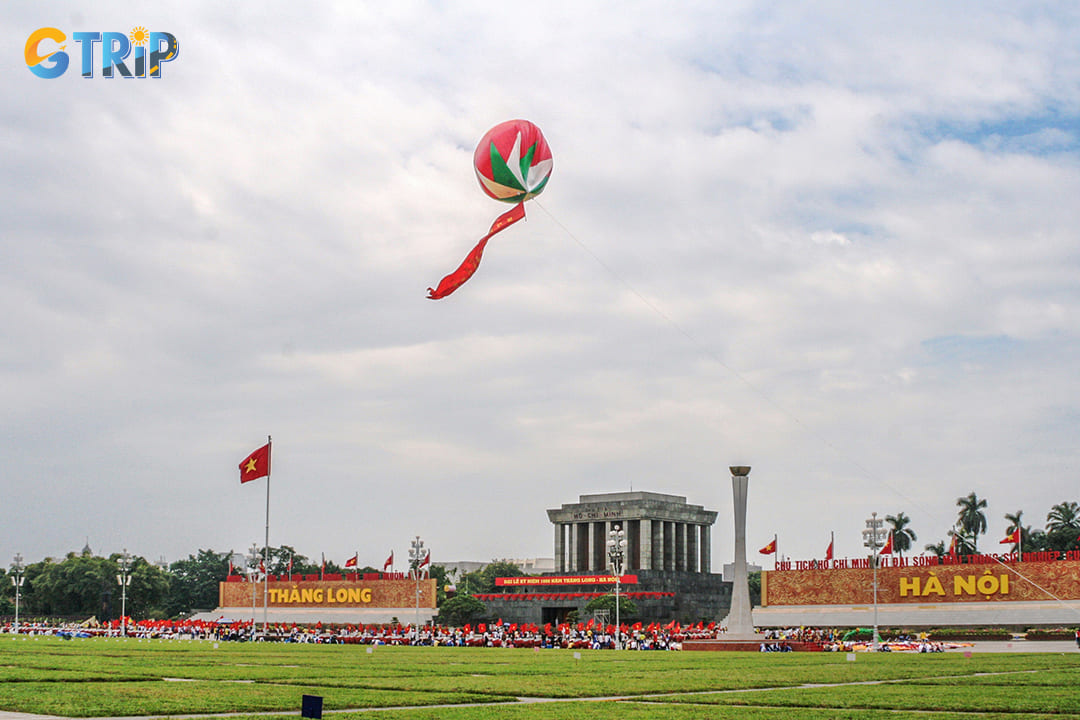
Over the decades, Ba Dinh Square has hosted a series of major national milestones
Things to do at Ba Dinh Square
Ba Dinh Square offers tourists a unique blend of cultural immersion, historical significance, and ceremonial experiences at the heart of Vietnam's political landscape. Beyond its historical importance, the square provides several meaningful activities that connect travelers to Vietnam's revolutionary past and contemporary national pride.
Witness the flag-raising and lowering ceremonies
The flag ceremonies at Ba Dinh Square rank among Hanoi's most stirring patriotic displays, drawing both locals and international tourists. These meticulously choreographed rituals occur twice daily at this historic location.
The morning flag raising ceremony begins at precisely 6:00 AM, when a contingent of the elite Honor Guard of the Vietnam People's Army marches into the square. Dressed in crisp white ceremonial uniforms, the honor guards perform the flag-raising ritual with exacting military precision. As Vietnam’s red flag with a yellow star ascends, the national anthem “Tien Quan Ca” echoes across the square, creating a solemn and patriotic atmosphere.
The evening flag-lowering ceremony takes place at 9:00 PM and follows a similar protocol but with a distinctly different atmosphere as darkness envelops the square. Both ceremonies last approximately 10 minutes and provide an authentic glimpse into Vietnam's national pride. These ceremonies occur daily regardless of whether the weather is sunny or rainy.
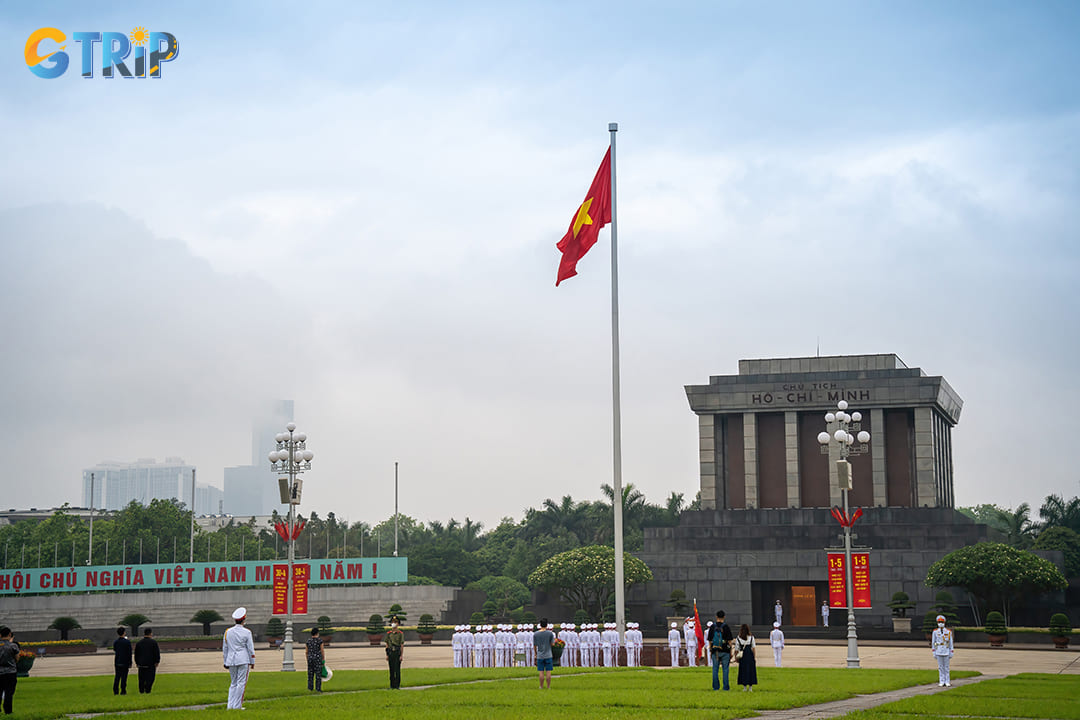
The morning flag raising ceremony begins at precisely 6:00 AM
Attend national ceremonies and events
Ba Dinh Square serves as the epicenter for Vietnam's most significant national celebrations and commemorations throughout the year. These events provide unique opportunities to witness Vietnamese culture and patriotism firsthand.
The square hosts grand celebrations on key dates in the Vietnamese calendar:
| Event | Date | What to expect |
|---|---|---|
| Independence Day | September 2 | Military parade, cultural performances, fireworks |
| Liberation Day | April 30 | Patriotic speeches, flower displays, musical concerts, flag ceremonies, official addresses, and public gatherings |
During these events, the square transforms with elaborate decorations, including massive floral displays, patriotic banners, and nighttime illuminations. Tourists attending these celebrations should arrive early, expect crowds, and be prepared for security checkpoints. The atmosphere during national ceremonies offers an incomparable window into Vietnamese collective identity and pride.
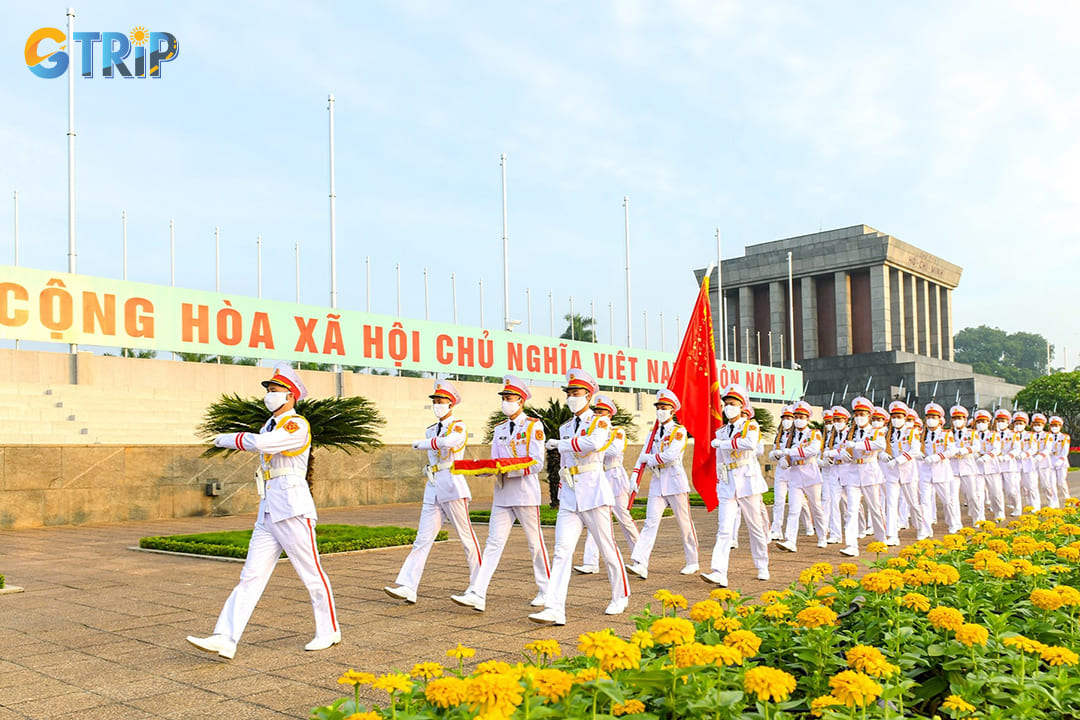
Ba Dinh Square serves as the epicenter for Vietnam's most significant national celebrations and commemorations throughout the year
Pay respects at the Ho Chi Minh Mausoleum
Paying respects at the Ho Chi Minh Mausoleum is often regarded as a solemn pilgrimage for many Vietnamese and a deeply meaningful cultural encounter for international travelers. This monumental structure, built of gray granite and marble, serves as the final resting place of President Ho Chi Minh, affectionately known as “Uncle Ho”. He is remembered not only as the founding father of modern Vietnam but also as a symbol of the country’s struggle for independence and unity.
Inside, the mausoleum exudes a quiet reverence. Visitors move slowly in a single file through the cool, dimly lit interior, passing by the glass sarcophagus where Ho Chi Minh’s embalmed body lies in state. The atmosphere is deeply respectful, talking, photography, and inappropriate behavior are strictly forbidden. Uniformed honor guards in pristine white dress ensure the sanctity of the space is preserved at all times.
Though the viewing lasts only a few minutes, the emotional weight of the experience resonates long after. For many, it is not just a glimpse of history but a powerful moment of reflection on Vietnam’s resilience and the legacy of a leader who dedicated his life to national liberation. It’s a must-visit for anyone seeking to understand Vietnam’s identity and reverence for its past.
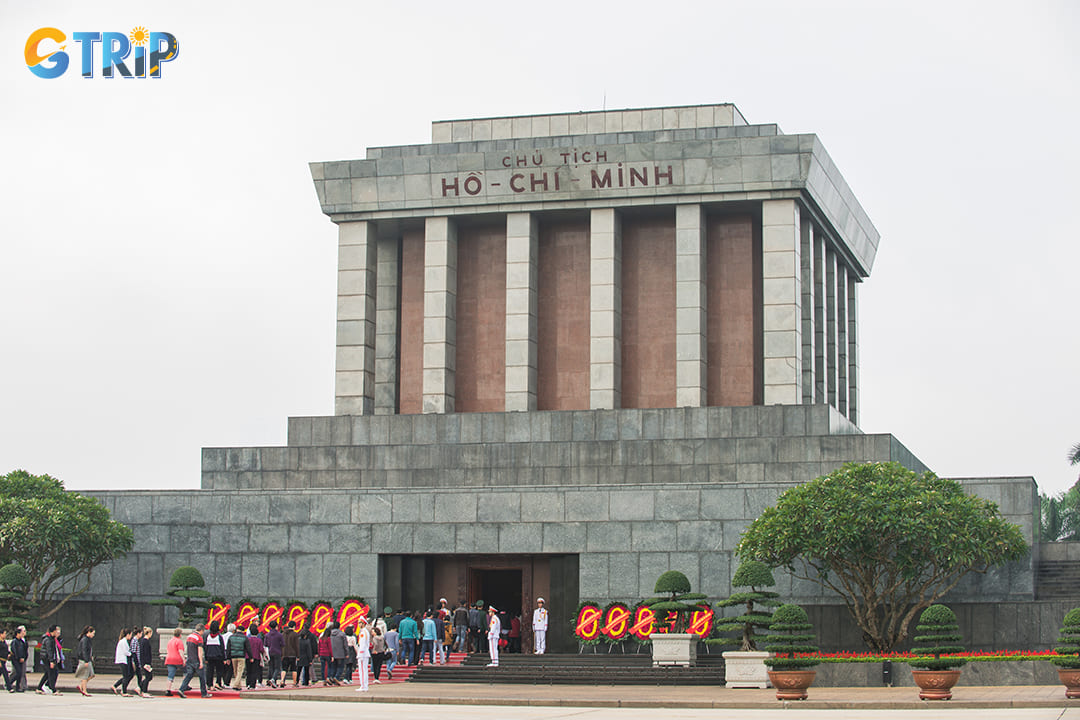
Paying respects at the Ho Chi Minh Mausoleum is often regarded as a solemn pilgrimage
Best photography spots at Ba Dinh Square
Ba Dinh Square offers a rich array of photogenic angles that reflect Vietnam’s historical weight and architectural charm. One of the most moving moments to capture is the daily flag-raising ceremony between 6:00 - 6:30 AM. Stand along the eastern edge of the square to frame the guards in white uniforms, the vibrant flag, and the soft morning mist. In the evening, head to the southern end of the square to photograph the Ho Chi Minh Mausoleum as the sunset casts a golden glow over its solemn granite facade.
Architectural photographers will enjoy shooting the nearby colonial-era government buildings. Their yellow walls, French-inspired design, and surrounding greenery offer striking compositions, especially in early morning or late afternoon light. For panoramic views, consider elevated spots from cafes or hotels on Hung Vuong Street. This is where you can capture the full expanse of the square, especially during national events when the space comes alive with activity.
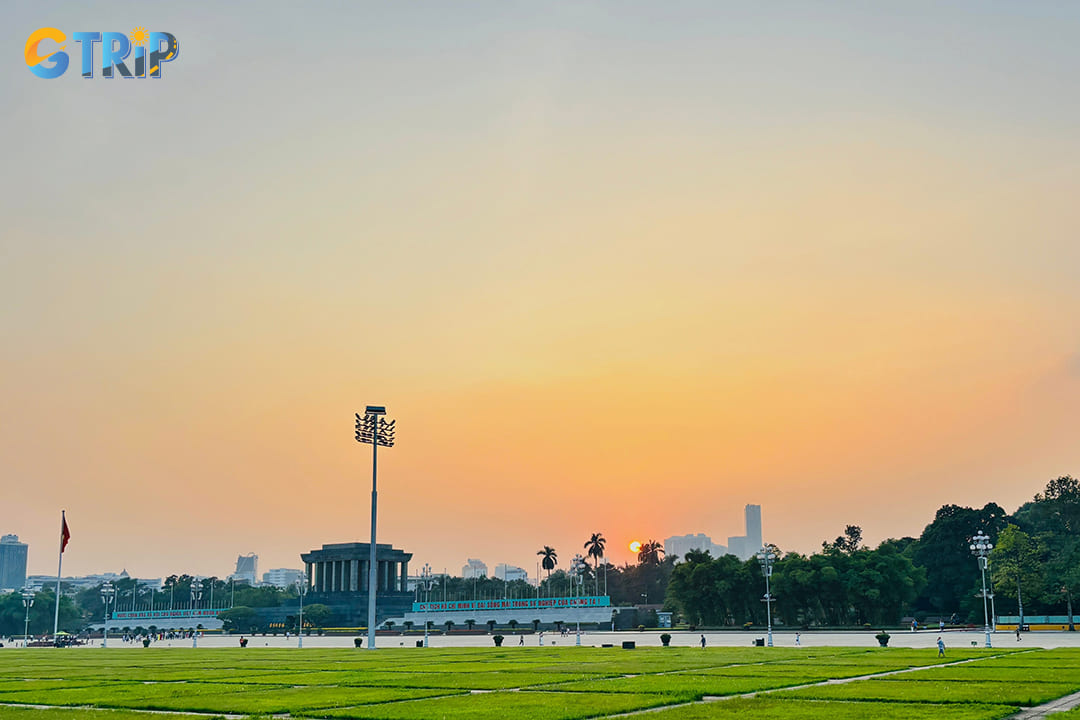
Ba Dinh Square offers a rich array of photogenic angles that reflect Vietnam’s historical weight and architectural charm
Opening hours and best times to visit Ba Dinh Square
Ba Dinh Square, one of Hanoi's most significant historical landmarks, welcomes tourists throughout the day with flexible hours that accommodate both early risers and evening visitors.
Opening hours and admission
- Daily access: 5:00 AM to 10:00 PM
- Admission fee: Free (no entrance charge to the square itself)
- Ho Chi Minh Mausoleum hours: 8:00 AM to 11:00 AM, Tuesday through Thursday, and weekends (closed Mondays and Fridays for maintenance)
- Security checks: Brief and mandatory when entering certain areas around the square
The square offers different experiences depending on when you choose to visit. Morning visits provide a peaceful atmosphere with cooler temperatures, while evening visits showcase the square beautifully illuminated against Hanoi's skyline.
Ceremonial times to mark on your calendar:
- Flag-raising ceremony: Daily at 6:00 AM (summer) or 6:30 AM (winter)
- Flag-lowering ceremony: Daily at 9:00 PM
- Changing of the guard: Every hour on the hour from 6:00 AM to 9:00 PM
Best time to visit
Early mornings between 6:00 - 8:00 AM offer the most atmospheric experience. You’ll find locals practicing tai chi, light crowds, and the stirring flag-raising ceremony, where guards march in sync to the national anthem as the red flag ascends against the dawn sky.
Photographers should also consider visiting at golden hour (5:00- 6:30 PM) when the warm light enhances the square’s architecture. The 9:00 PM flag-lowering ceremony provides a quieter but equally respectful atmosphere.
Seasonal tips
| Season | Weather | Crowds | Tips |
|---|---|---|---|
| Spring (Feb - Apr) | Mild, some rain | Moderate | Great weather, ideal for walking tours |
| Summer (May - Aug) | Hot, humid, rainy afternoons | High (esp. July - Aug) | Go early to avoid the heat |
| Autumn (Sep - Nov) | Cool, dry, sunny | Moderate | Best season overall |
| Winter (Dec - Jan) | Cool to chilly | Low (except holidays) | Fewer crowds, bring a jacket |
During holidays like September 2 (Independence Day) or April 30 (Reunification Day), expect large crowds and official ceremonies. While access may be limited, the atmosphere offers a rare look into Vietnam’s patriotic spirit.
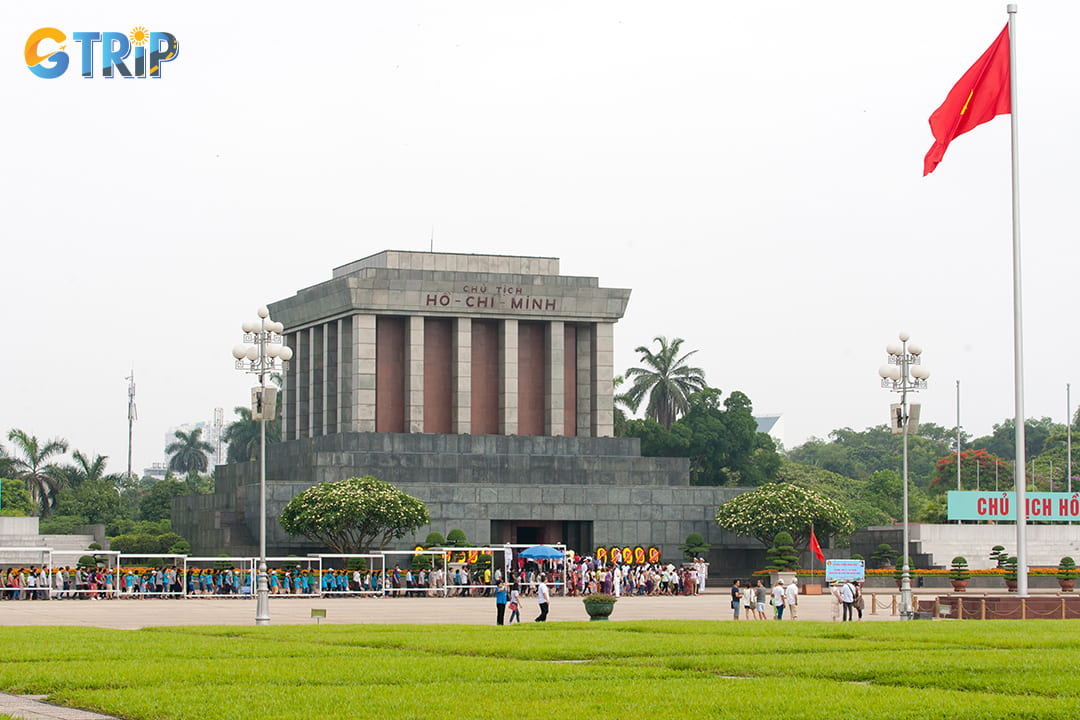
Ba Dinh Square welcomes tourists throughout the day with flexible hours
How to get to Ba Dinh Square?
Reaching Ba Dinh Square is straightforward as it's centrally located in Hanoi's political district. The square is well-connected to the rest of the city through various transportation options, making it accessible regardless of your budget or travel preferences. Here's a comprehensive breakdown of how to reach this historic landmark from different parts of Hanoi.
By motorbike
Renting a motorbike offers flexibility and remains one of the most popular ways for tourists to navigate Hanoi's bustling streets.
- Rental costs: 100,000 - 200,000 VND per day (approximately $4 - $8)
- Parking fee: 5,000 - 10,000 VND ($0.20 -$0.40) at nearby parking lots
- Availability: Widely available from hotels and rental shops throughout the Old Quarter
If you're comfortable navigating Hanoi's chaotic traffic, simply head west from Hoan Kiem Lake along Dien Bien Phu Street. GPS navigation works reliably in the area, and the square is marked clearly on most maps. Look for designated parking areas around the square, as parking directly on the square is prohibited.
By taxi or ride-hailing services
For a convenient and comfortable ride, especially during Hanoi’s hot or rainy days, taxis and ride-hailing apps like Grab and Be are excellent options. A trip from the Old Quarter to Ba Dinh Square typically costs between 55,000 to 100,000 VND (about $2.25 to $4), depending on traffic and the service used.
Traditional taxis can be flagged down on the street, while Grab and Be rides are booked through their mobile apps. Most drivers will recognize “Ba Dinh Square”, but it’s helpful to show the Vietnamese name “Quang truong Ba Dinh” on your phone. When using apps, set your destination as “Ho Chi Minh Mausoleum” or “Ba Dinh Square” to ensure accurate pickup and drop-off.

Reaching Ba Dinh Square is straightforward as it's centrally located in Hanoi's political district
By bus
The public bus system offers the most economical way to reach Ba Dinh Square, with several routes connecting it to major areas of Hanoi.
- Ticket price: 7,000 - 9,000 VND per journey ($0.30 - $0.40)
- Key routes serving Ba Dinh Square:
- Bus 9: Connects Hoan Kiem Lake to Ba Dinh
- Bus 23: From the West Lake area
- Bus 14: From Long Bien area
Buses typically run from 5:00 AM to 10:00 PM. Look for stops near Hung Vuong Street or Le Hong Phong Street, both within a short walking distance to the square. Purchase tickets directly from the conductor when boarding the bus.
By cyclo
For a nostalgic and leisurely journey, traditional cyclos (three-wheeled bicycle taxis) can take you to Ba Dinh Square while allowing you to enjoy Hanoi's scenery.
- Average cost: 150,000-250,000 VND ($6 - $10) from Old Quarter
- Journey time: 30 - 45 minutes, depending on traffic
- Negotiation: Always agree on the price before starting your journey
Cyclo drivers often offer commentary about nearby landmarks during the ride, making this a sightseeing opportunity in itself. While not the fastest option, it's certainly one of the most memorable ways to reach the square, especially for first-time visitors.
By walking
Walking to Ba Dinh Square is entirely feasible if you're staying in the central Hanoi districts.
- Distance from Old Quarter: Approximately 2.5 km (1.5 miles)
- Walking time: 30 - 45 minutes at a moderate pace
- Route: Follow Hang Gai to Hang Trong, continue to Hang Bong, then onto Phan Dinh Phung Street
The walk takes you through charming Hanoi neighborhoods and provides an opportunity to observe local life. Consider walking early morning or late afternoon to avoid the midday heat, and be cautious crossing major intersections. The route is generally flat with adequate sidewalks, making it suitable for most fitness levels.
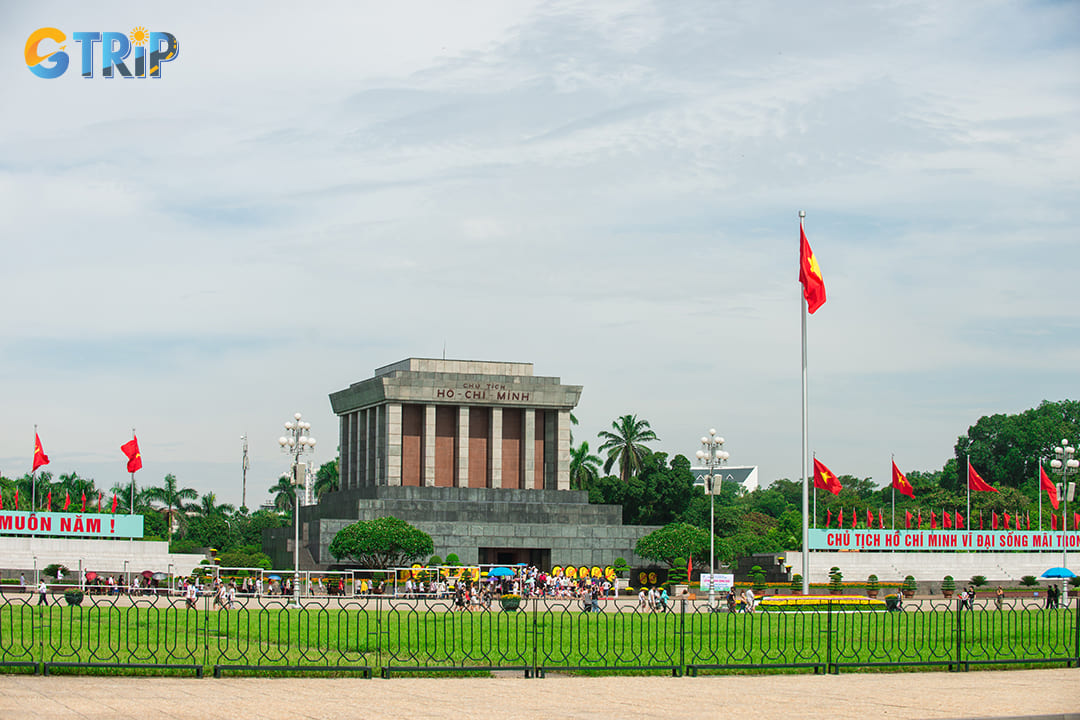
Walking to Ba Dinh Square is entirely feasible if you're staying in the central Hanoi districts
Practical tips for visiting Ba Dinh Square
To make your visit to Ba Dinh Square meaningful and smooth, a bit of planning goes a long way:
- Arrive early (by 7:00 AM) for a peaceful atmosphere and better photos, especially during flag ceremonies.
- Dress modestly with shoulders and knees covered, as a sign of respect.
- Bring ID, as security checks are common around the mausoleum and government buildings.
- Stay hydrated and wear comfortable shoes, especially in hot weather with little shade.
- Follow photography rules. Photos are allowed in the square but not inside the mausoleum.
- Be respectful: keep noise low, avoid running, and observe local etiquette.
- Join a guided tour to gain insight into Vietnam’s history and political legacy.
- Visit on weekdays to avoid crowds and enjoy shorter lines at key sites.
These simple tips can help you enjoy the square with deeper appreciation and minimal hassle.

To make your visit to Ba Dinh Square meaningful and smooth, a bit of planning goes a long way
Nearby attractions from Ba Dinh Square
Within walking distance, you can discover architectural masterpieces, religious sites, and historical monuments that showcase Vietnam's rich cultural heritage. These nearby attractions complement a visit to Ba Dinh Square, allowing travelers to create a comprehensive itinerary in this historically significant area of Hanoi.
One Pillar Pagoda
Just steps away from Ba Dinh Square stands the iconic One Pillar Pagoda, one of Vietnam's most distinctive Buddhist temples. Built in 1049 during the Ly Dynasty, this unique structure resembles a lotus flower rising from the water, symbolizing purity in Buddhist philosophy. Emperor Ly Thai Tong commissioned the pagoda after dreaming of meeting the bodhisattva Avalokiteshvara, who handed him a lotus flower while seated on a lotus throne.
The pagoda's distinctive design features a wooden shrine balanced atop a single stone pillar, creating the illusion that it's floating above a small pond. Though destroyed by French forces in 1954 before their withdrawal from Vietnam, the government faithfully reconstructed it shortly afterward. Tourists often come to make offerings for fertility and good fortune, continuing a tradition that has persisted for nearly a millennium. The surrounding gardens offer a peaceful retreat from Hanoi's bustling streets, making it an essential stop when exploring the Ba Dinh area.
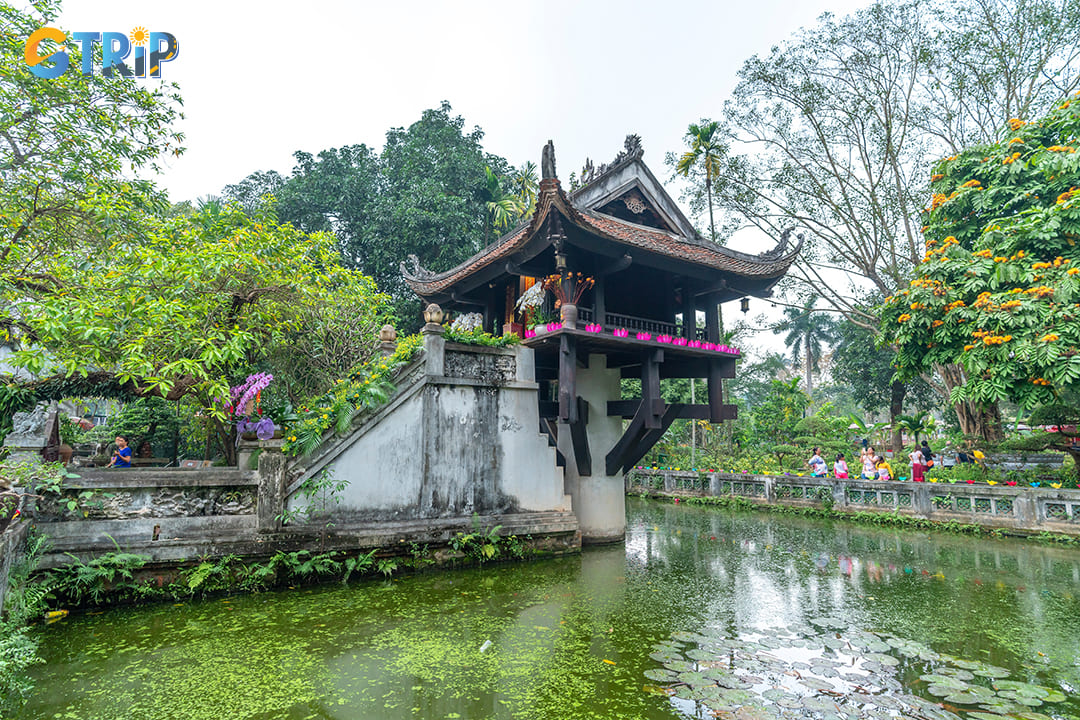
Just steps away from Ba Dinh Square stands the iconic One Pillar Pagoda, one of Vietnam's most distinctive Buddhist temples
The Presidential Palace
Located just northwest of Ba Dinh Square, the Presidential Palace stands as a striking example of French colonial architecture in Hanoi. Built between 1900 and 1906 to house the French Governor-General of Indochina, this magnificent yellow structure features elements of Italian Renaissance design with distinctive French influences. After Vietnam gained independence, Ho Chi Minh refused to live in this symbol of colonial rule, opting instead for a modest stilt house within the palace grounds.
While the palace interior remains closed to the public as it continues to serve as a government building for diplomatic functions, you can explore the meticulously maintained gardens and grounds. The palace complex includes:
- Ho Chi Minh's stilt house where he lived from 1958 until his death
- The Presidential Palace Historical Site museum
- Botanical gardens with exotic plants and trees
- The fish pond where Ho Chi Minh often sat to read and work
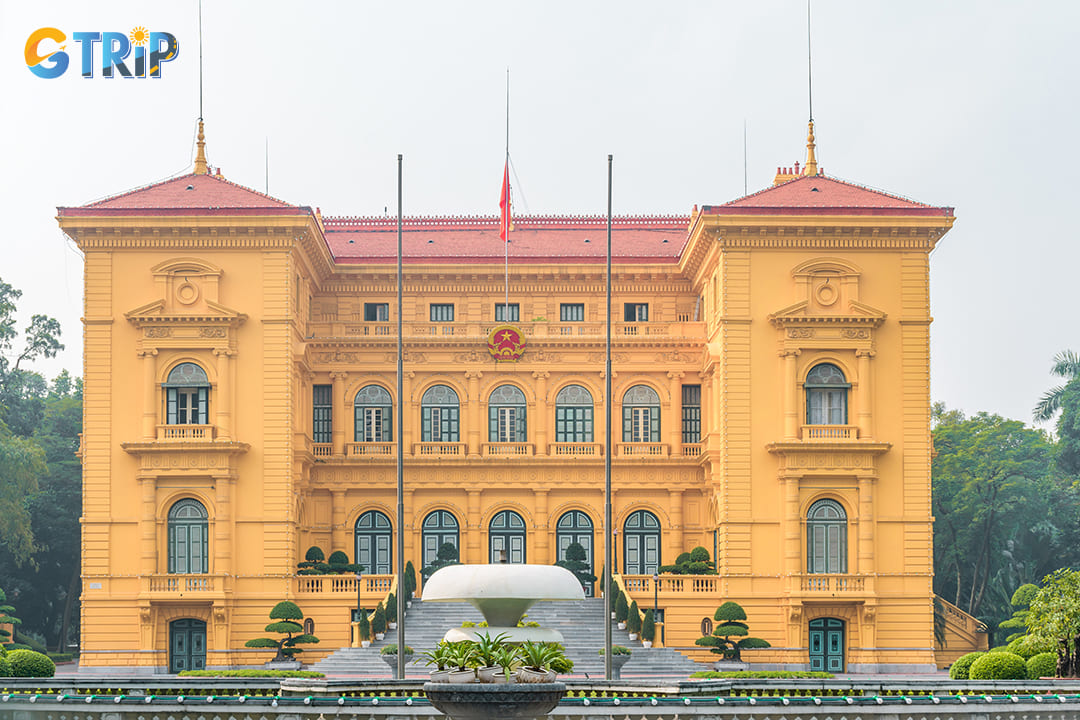
Located just northwest of Ba Dinh Square, the Presidential Palace stands as a striking example of French colonial architecture in Hanoi
Quan Thanh Temple
Situated at the southeastern corner of West Lake and a short walk from Ba Dinh Square, Quan Thanh Temple dates back to the 11th century during the Ly Dynasty. This Taoist temple was built to honor Tran Vu, one of the principal deities in Vietnamese Taoism who is associated with the north and believed to control winds and rain. The temple stands as one of the Four Sacred Temples that were built to protect Hanoi from malevolent spirits in each cardinal direction.
The temple's most impressive feature is a 4-meter-tall, 4-ton black bronze statue of Tran Vu created in 1677. This imposing figure holds a sword in one hand while the other rests on a tortoise, symbolizing longevity and strength. The intricate woodcarvings throughout the temple showcase the exceptional craftsmanship of the 17th and 18th centuries. You can witness local devotees making offerings and praying for protection, especially during the temple's festival held in early spring. The tranquil courtyard provides a peaceful contrast to the busy streets of Hanoi, making it a cultural treasure worth exploring near Ba Dinh Square.
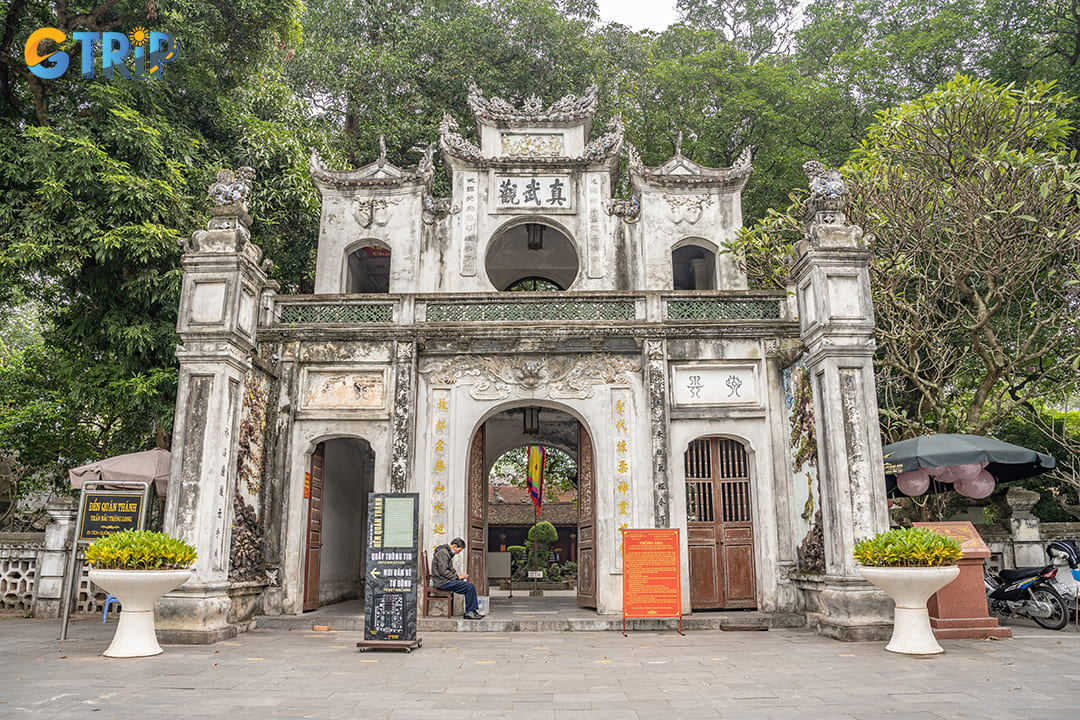
Situated at the southeastern corner of West Lake and a short walk from Ba Dinh Square, Quan Thanh Temple dates back to the 11th century during the Ly Dynasty
Bac Son Monument
A short distance from Ba Dinh Square, the Bac Son Monument commemorates the revolutionary martyrs who sacrificed their lives for Vietnam's independence. Created by sculptor Nguyen Hai in 1995, this imposing stone sculpture stands 12.9 meters high and features 10 figures representing different roles in Vietnam's revolutionary struggle.
The monument takes its name from the Bac Son uprising of 1940, one of the earliest organized revolts against French colonial rule following the start of World War II. This rebellion in the northern mountains is considered a crucial precursor to Vietnam's independence movement. Tourists often find the monument particularly photogenic at sunset when dramatic lighting accentuates the heroic poses of the figures against Hanoi's skyline.
Around the monument, you'll find:
- A small but well-maintained garden area with benches
- Information plaques explaining the historical context in Vietnamese and English
- A regular ceremonial changing of the guard
- Excellent photo opportunities with Ba Dinh's historical buildings in the background
The monument provides a powerful reminder of Vietnam's revolutionary past and serves as an important cultural landmark in the Ba Dinh district.
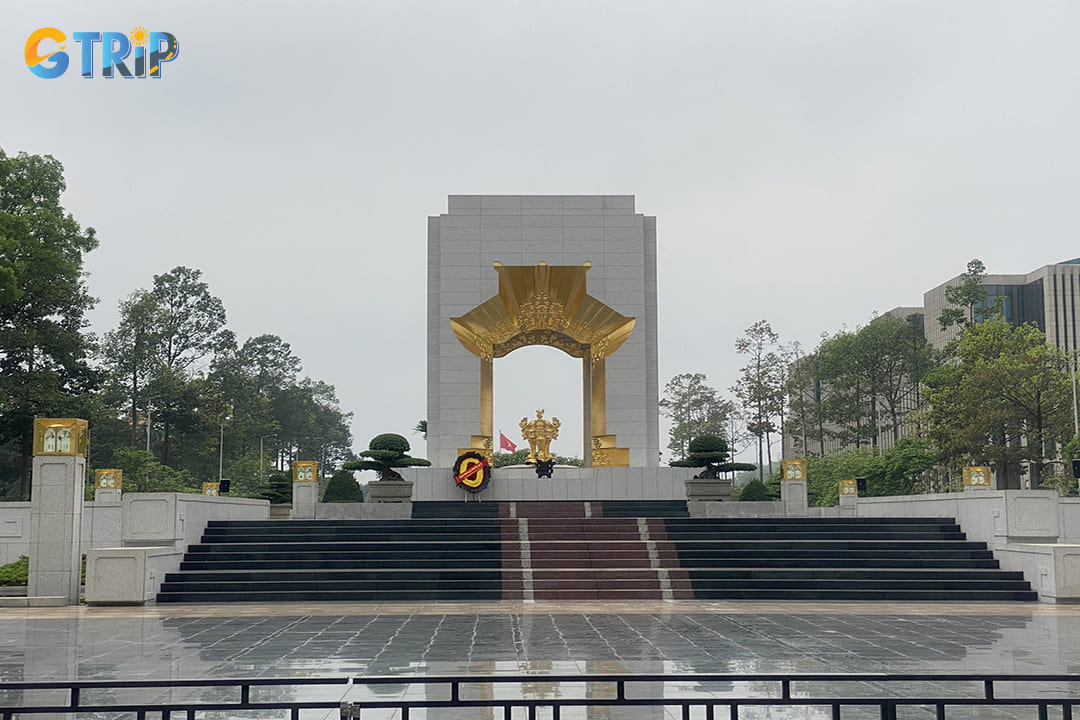
Bac Son Monument commemorates the revolutionary martyrs who sacrificed their lives for Vietnam's independence
Imperial Citadel of Thang Long
Just a 10-minute walk from Ba Dinh Square, the Imperial Citadel of Thang Long is a UNESCO World Heritage Site and the former political center of Vietnam for over 1,300 years. The site blends remnants from dynastic eras, French colonial buildings, and military relics from the Vietnam War.
Key highlights include the iconic Flag Tower, the grand Doan Mon Gate, the foundation of Kinh Thien Palace with its dragon carvings, and the D67 underground bunker used during wartime. Archaeological zones reveal artifacts dating back to the 7th century. Exhibition halls display ceramics and historical items, while audio guides in several languages provide context for this layered site, making it a must-visit for history enthusiasts.
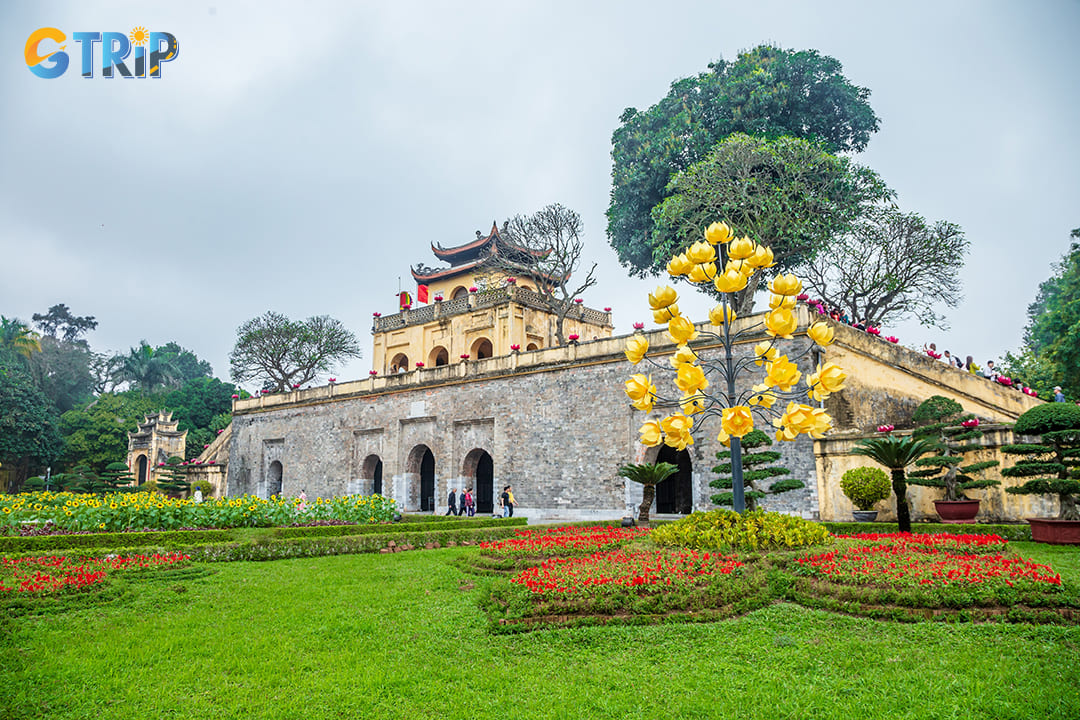
The Imperial Citadel of Thang Long is a UNESCO World Heritage Site and the former political center of Vietnam for over 1,300 years
Experiencing Ba Dinh Square offers a profound glimpse into Vietnam's rich history and vibrant culture. This iconic landmark is where the past meets the present, encapsulating the spirit of Hanoi and its enduring legacy. For travelers seeking to connect with meaningful moments or simply to soak in the atmosphere of an extraordinary place, Ba Dinh Square provides a powerful backdrop. To make the most of your time in the capital, book a guided Hanoi tour and other cities from Hanoi with GTrip - Vietnam Travel Agency. Our expert local guides will help you uncover the stories behind Ba Dinh Square and nearby attractions, ensuring a meaningful and seamless experience. Let GTrip be your trusted companion as you explore the essence of Hanoi, past and present.

